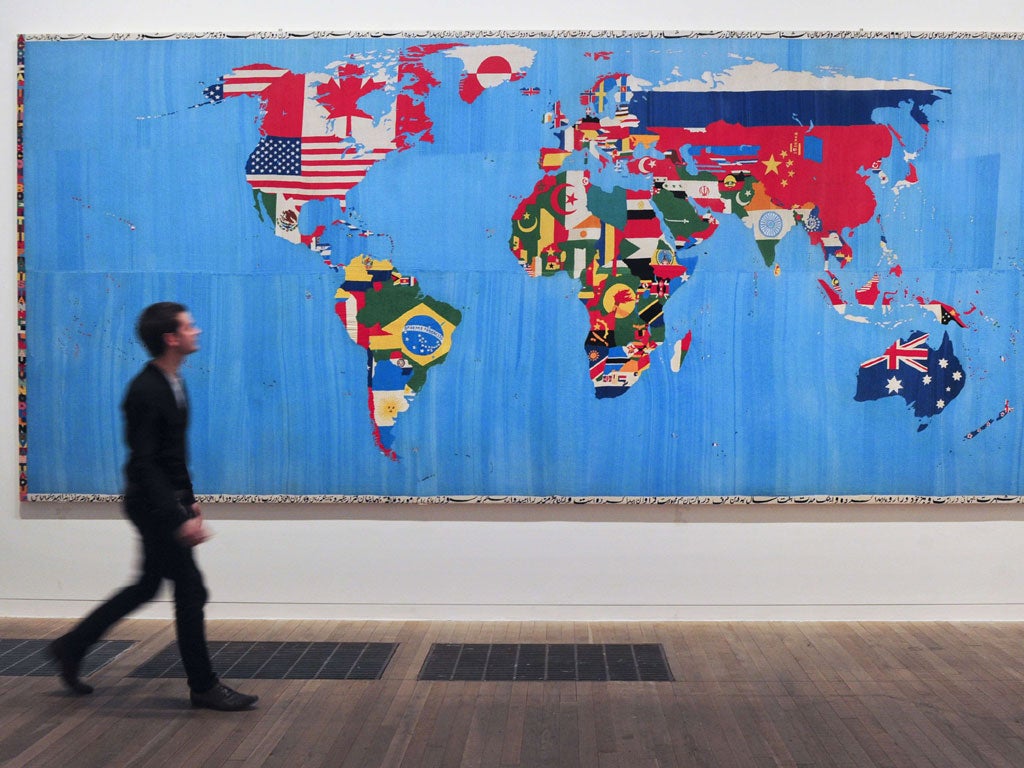Alighiero Boetti, Tate Modern, London
The star of Arte Povera is full of bright ideas in a show that winds its way through the human condition and its orderly creations, from postage stamps to vast embroideries

Halfway through Tate Modern's Alighiero Boetti show is a work that you will almost certainly never see, or at least not see in action. Called Lampada annuale (Annual Lamp), it consists of a mirror-lined black box or crate holding a single, outsized light bulb.
Boetti, who died of a brain tumour in 1994 at the age of 53, programmed this bulb to come on sporadically once a year for 11 seconds at a time. In any given year, you have a slightly better than one in three million chance of being near Lampada annuale when it springs to evanescent life. In the 59 days Boetti's exhibition is on at the Tate, these odds would shorten to around one in 500,000 – if the lamp were obliging enough to come on while it is in London, and in gallery opening hours. I don't know that I have ever looked at a work of art with such longing, or with such sure expectation of disappointment.
It is tempting to see this small story as a parable of Boetti's life. Born in Turin on 16 December 1940, he was fascinated by his own mortality: not, it would seem, by the fact that he would die so much as that the time between his birth and death would be measured out in man-made increments.
In 1971, five years after he made Lampada annuale, Boetti showed 16 DICEMBRE 2040 – 11 LUGLIO 2023 – a pair of wall-mounted brass plaques of the kind you see outside Italian doctors' offices, each bearing one of the titular dates. The first marked the centenary of the artist's birth, the second the date on which, measured by actuarial tables, it seemed most likely that he would die. Seen at the time they were made, the plaques must have had an air of tempting fate. Nearly 20 years after Boetti's early death, it is clear that they were.
The story that both these and the lamp tell – the one told, to some extent, by all of Boetti's work – is of heroic failure, particularly the artist's own. At the heart of their interest is man's need to think in metaphor, to control the world by naming and systematising it. For every thing there is its metaphorical double, including Boetti himself. From the mid-1960s, he took to referring to himself as Alighiero e Boetti – Alighiero and Boetti – as though there were two of him, shown side-by-side in photomontaged self-portraits called Gemelli (Twins). All kinds of metaphorical systems fascinated him: numbers, postage stamps, alphabets, dates, and, above all, maps.
If you only know one body of Boetti's work, then it is likely to be the Mappa series, given a vast room of its own in the Tate Modern show. From the early 1970s until shortly before his death, Boetti worked with Afghan weavers and weavers in exile to produce rug-sized embroidered maps of the world, each country picked out in the colours of its national flag. You can see the appeal for a man obsessed with metaphors: a globe represented as a rectangle, land masses by shapes, geopolitics by symbolic colours and patterns which changed as countries became independent or were occupied or embroiled in civil war.
So many systems, so much representation. And yet what strikes you about the Mappe is their imprecision, the way that human frailty inevitably wins out over the human drive to exactitude. In one map, the sea is unexpectedly coloured pink rather than blue. Landlocked Afghans had no tradition of mapping, certainly not of oceans. Having never seen the sea, they saw no good reason why it should be stitched in blue rather than pink, the latter dye being cheaper and more plentiful than the former. Boetti, reportedly, was delighted.
He was probably the most famous of the artists of Arte Povera, although he is also noted for having turned away from the movement. Like many well-known art-historical facts, this one is not entirely true. While Boetti may have stopped making work from trademark Povera materials such as bits of kindling (eg, Little Coloured Sticks, 1968), he none the less remained fascinated by the smallness of man; or, rather, by man's tragicomic refusal to admit to that smallness, his insistence on dealing with the world by scaling it down to the span of his own mind.
Boetti's materials may have changed, but his humanity did not. At the heart of what he saw as the great cosmic joke of being alive was a sense of his own mortality: that, in spite of what Warhol said, we are not each given 15 minutes of fame, but 11 seconds of light in a darkened gallery when no one is there to see it.
To 27 May (020-7887 8888)
Art choice
Enjoy the artistic freebies of our capital: there's a new fourth plinth sculpture in Trafalgar Square, by Scandinavian duo Michael Elmgreen and Ingar Dragset. A golden boy riding a rocking horse, its gently mocking subversion is worth a look. Then pop over to Tate Modern for a last chance to see Tacita Dean's take on the Turbine Hall, FILM (to 11 Mar).
Subscribe to Independent Premium to bookmark this article
Want to bookmark your favourite articles and stories to read or reference later? Start your Independent Premium subscription today.

Join our commenting forum
Join thought-provoking conversations, follow other Independent readers and see their replies